Cooperl Arc Atlantique: The European pig specialist
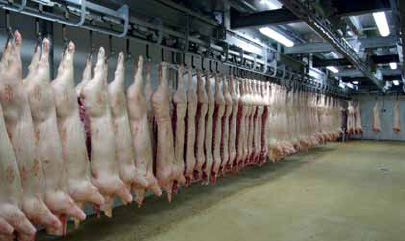
From starting out as a small cooperative, Cooperl Arc Atlantique has managed to build a vast pork and meat empire in the West of France, to become a leader in expertise and know-how, from the pig farm to the end consumer. Pig Progress visited the cooperative’s headquarters in Lamballe, Brittany, France – and learnt there is more to pig production than just producing meat.
Two employees – that is what Cooperl Arc Atlantique started with, back in 1966. At that time, the French pork and meat giant was only a small cooperative, consisting of 24 members.
The cooperative’s present-day success is easily summarised by looking at the current number of members: 3,600 members – of which 2,700 are pig producers. Together, they produced 5,800,000 pigs in 2010, making Cooperl Arc Atlantique, headquartered in Lamballe, Brittany, France’s largest pig producer, and number four in Europe.Growth is what is anticipated for the years to come. Anne-Marie Boullier, the company’s head of communication, explains: “A successful generation change happened recently, with a new general director who arrived in 2008 and a renewed executive committee consisting of young people.” Under Emmanuel Commault, general manager, eight directors have been put in charge of different specialised branches: animal nutrition, pig production, meat industry, salting industry, butchery delicatessen, bovine industry, specialised distribution and environment business. Several businesses will be discussed in detail below.
A better gross margin per sow
Cooperl’s production group consists of 2,700 farmers, organised in nine geographical areas each having its own technical team. The cooperative employs a total of 42 breeding technicians, 17 building technicians and 22 veterinarians, in order to be as close as possible to its members.
Most members are family farmers with an average of 200 sows. “Some larger farms are now starting up having 1,000 to 1,500 sows,” says Pierre Le Guilloux, director of specialised distribution. In 1994, Cooperl joined forces with another group of producers to create Nucleus, nowadays the leading French pig genetic scheme. Owing to this scheme, Cooperl’s pig farmers nowadays have better technical and economical results compared to the average farm results achieved in Brittany, France’s main livestock rearing area.
A comparative study made in 2009 by independent organisations (CER, EDE) proved this – Cooperl producers have a better gross margin per sow (€953) compared to those who are not in the cooperative (€718); for more figures, see Table 1.
This margin difference is created for 40% by lower feed costs, for 21% by the selling price of the finishing pigs, and for 26% by sow productivity (see Table 2). Nowadays, around 10% of the Cooperl farms reach over 29 finished pigs per sow, while 85% of the its pig farms regularly have a feed conversion ratio which is below 3.0, with 10% even being close to 2.60.
Research and innovations
The specialised distribution branch of Cooperl Arc Atlantique has several core functions. One of them is supplying livestock and equipment materials, using eight stores spread out in various places all over Brittany. Le Guilloux explains, “We started only with pig equipment and we have widened our range of products to non-member customers.” He says that a new logistic platform of 5,000 m2 will be built by 2012 in Plestan, Brittany, in order to be able to deliver goods to any customer, all over France.
Another core business of the this Cooperl branch is Research and Development, particularly in livestock building construction. Up until now, Cooperl members have been testing innovative buildings – and at the moment even a whole experimental farm is being studied, not having a slurry storage facility. The principle here is to separate the liquid from the solid manure as quickly as possible. This building consists of four independent rooms and phase separation is integrated into the building thanks to a bottom floor having a ‘V’ shape and a slope of 1.5%. The target is to trap 90% of the phosphorus and 55% of nitrogen, while reducing ammonia emmissions by 54%.
Le Guilloux says, “We have been working on such a building for two years and the first building has been launched successfully very recently near Vitré. Cooperl’s target is to build a series of four buildings for the upcoming Space (13-16 September) to promote this innovation during the exhibition.The third activity of the specialised distribution sector of Cooperl Arc Atlantique is to promote its know-how abroad. “We provide global expertise to pig farmers who need permanent improvements,” says Le Guilloux. The main targets for promoting the group’s know-how would be Eastern Europe and China. Le Guilloux believes that innovations will be the key to enter new markets. “Our group offers several experts under the same roof,” he adds.
100,000 pigs slaughtered per week
Presided by Jean-Michel Mauboussin, the meat industry branch of Cooperl composes of three slaughterhouses: one in Lamballe with 45,000 pigs slaughtered per week; another located in Montfort, with 35,000 pigs slaughtered per week, and the last in Saint-Maixent in Poitou-Charentes region, with 20,000 pigs per week. In addition, there are two processing units: Rochetoirin, in Rhône-Alpes region, and La Verrie ‘Meat Services’ located in Pays de Loire, specialised in slicing, packaging and freezing of meat. This last location can process any raw material (fresh, frozen) from any species (pork, beef, veal, poultry, mutton or goat meat) and can do any custom cuts or à la carte packagings.
Lamballe is France’s largest slaughtering and cutting plant, employing a total of 1,300 people (permanent and interim). The facility deals with 45,000 to 47,000 pigs per week, at a speed of 650 pigs per hour. “We have invested a lot to reduce the difficult work and mechanise a lot,” says Mauboussin. After an individual classification, official marking by the external company Uniporc and a quick refrigeration of five hours, the half-carcasses are first of all cut into loins, shoulders or hams. “Only for loins, we have 150 destinations,” says Mauboussin.Six deboning lines are dedicated to loin for supermarkets; exports; breasts (two lines); shoulders and hams. An impressive storage consisting of 9,000 trays of cut product is distributed in four rows and managed by two robots per row, kept at a standard temperature of between 0 and 2°C. About 10% of the cut products is then further processed into e.g. pâtés, cooked roasts, lardons, etc.
What are the advantages of the Lamballe site? “The main plus is the volume and the capacity of the slaughterhouse which allow us to better sort the carcasses,” says Mauboussin. He adds that another advantage is that everything is under the same roof, with no break in the cold chain. With the supermarket orders centralised in Lamballe, there is a real complementarity between the three slaughterhouses. This complementarity also exists among the six salting units, representing a total production of 70,000 tonnes per year (see Table 2).
| Emmanuel Commault, Cooperl general manager: “We face many challenges” |
Emmanuel Commault became Cooperl’s general manager in 2008, at the age of 35 years, succeeding his father, who had run the group since 1982. His grandfather was also in the pig business, as he used to be a pig farmer. How can the year 2010 be reported and what is the pig production situation in Brittany? “French pig production just went through four years of an extremely strong economic crisis. This crisis started in 2007 with the explosion of grain prices which occurred again last year. The French and Breton pig production is ultra-competitive both on economical and technical sides. In spite of high technical performances, the financial strength of the Breton pig producers suffered a lot and we are expecting a significant drop of about 10% in Brittany’s pig herd within the next 18 months. Breton farmers are family farmers and some perform less than others. The less successful farms will have to stop their activities. This restructuring process has already started and will progressively lead to the creation of larger pig production units within a strong regulatory framework.”What are the consequences of this situation on the meat industry side? “The farm restructuring process has direct consequences on our industrial activities. It will accelerate the meat industry’s restructuring which started in 2008 with the merger of Cooperl Arc Atlantique and Arca cooperative, then followed by the buyout of Brocéliande, French leader in salting store brands. Brocéliande has been entirely owned by Cooperl Arc Atlantique since 2010. That is another illustration of our industrial strategy – which is focused on the optimisation of our industrial performances and processes, while bringing more added value to the final product. The last example of this strategy is the purchase of Défi Viandes in March 2011, a network of 83 city centre butcheries, mainly based in city centres in the North of France under several brands.” What are your other actual main issues? “During the last Space exhibition, we launched a ‘collective group against the social dumping in Europe’, and I am vice-president. This group, uniting most of the French meat industry organisations, was created because European rules related to interim work are not respected – particularly in Germany. Interim labour costs are low in Germany, around €7 per hour for foreign employees, while German employees’ costs (wage and payroll charges) amount to €15. This is at €20 in France and €30 in Denmark. Germany is the only European country which does not respect European rules regarding interim work and we lodged a complaint at the beginning of January to the European Commission which considered it as admissible. “The European Commission has launched a working group on this question which will be at the centre of a colloquium organised for early May, by the European Parliament. We are backed by most of the market players of the French meat industry and the petition we launched at Space has been signed by 13,000 company directors from the food industry. This petition has also been signed by our president, Nicolas Sarkozy. Our aim is to develop this collective group through Europe and to denounce the German social dumping which destroys our farms, our jobs and meat production in France.” What are your main investment projects for 2011? “Our investment programme is particularly relevant this year and will represent around €30 million. The aim of this programme is to go on improving the industrial performances of our 15 plants.” What are the main assets of your group to cope with all these challenges? “One of the keys to our success is that we are still a true cooperative. Our members are farmers who are still extremely involved in the cooperative life and its decision processes. Cooperl Arc Atlantique is still a cooperation project of which the aim did not change in 45 years: To contribute to the economic development of the region so that a maximum of men and women can live in the region of their work.” What about your international development projects? “We have been selling goods and services abroad for years and around 36% of our turnover is actually made in exports. We have to go on with our international development, but in the frame of our cooperative organisation. Cooperl Arc Atlantique and the Russian Pulkovo group of companies based in St Petersburg signed an agreement in December 2009 to establish a joint centre for 2,700 sows for pig breeding and selection, with an investment estimated at 2.5 billion roubles (€50 million). We are still working on the Russian market which is a strategic one for us in several respects, and we are ready to answer to any other opportunities in this market. “In addition, we are present in China in the province of Henan through a post-weaning unit of 20,000 places and an insemination center under the filtered air technology. China has a wide investment programme of 200 insemination centres and the Chinese appreciate our cooperative structure.” |
Cooperl investments About 40 employees work for the Environment branch of Cooperl Arc Atlantique, managed by Franck Porcher. Approximately 25 years of research around environment have led to the creation of various new businesses and innovative solutions. Porcher says: “Since 1992, we have invested €80 million on the environment, in order to create an essential branch and new activities.”
|
Cooperl: Key figures in 2010 • Number of members: 3,600 members (2,700 pig producers) • Number of pigs produced per year: 5,800 000 • Number of pigs slaughtered per year: 4,940,000 • Total feed production: 1,650,000 tonnes in three feed plants (Plounérin, Plestan, Vitré) • Pig feed production: 1,300,000 tonnes • Number of employees: 4,230 • Total group turnover: €1.75 billion • Meat industry turnover: €700 million |
 Beheer
Beheer

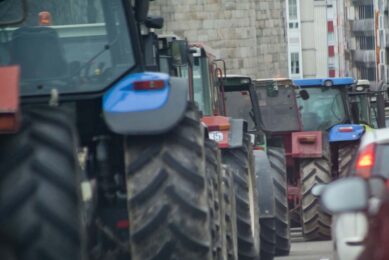
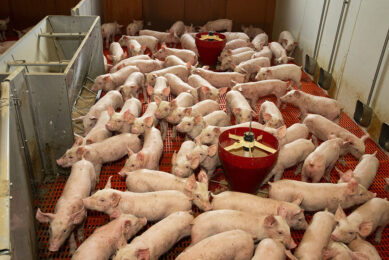
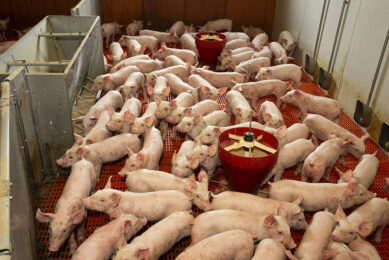
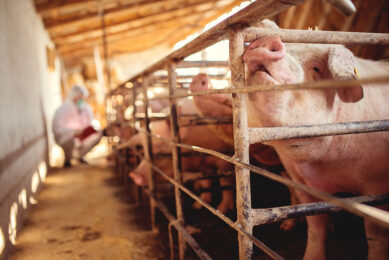



 WP Admin
WP Admin  Bewerk bericht
Bewerk bericht